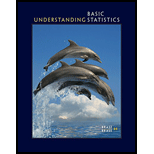
Terminology Match each of the following tests to the appropriate description: test of independence: test of homogeneity: test of goodness of fit.
test to determine if different populations have the same proportion of specified characteristics
test to determine if two variables are statistically independent
test to determine if a population has a specified distribution
The match of each of the following tests to appropriate description: test of independence; test of homogeneity; test of goodness of fit. The tests are:
(i) Test to determine if different populations have the same proportion of specified characteristics.
(ii) Test to determine if two variables are statistically independent.
(iii) Test to determine if a population has a specified distribution.
Answer to Problem 1CR
Solution:
(i) The test of homogeneity can be used to determine if different populations share the same proportions of specified characteristics.
(ii) The test of independence can be used to determine if the two variables are statistically independent.
(iii) Test of goodness of fit used to determine if a population has a specified distribution.
Explanation of Solution
A chi square test of homogeneity tests the claim that different population shares the same proportions of specified characteristics.
The chi square test of independence is used to test for the independence of two variables. Hence the test of independence can be used to determine if the two variables are statistically independent.
Test of goodness of fit used to determine if a population has a specified distribution.
Want to see more full solutions like this?
Chapter 11 Solutions
Understanding Basic Statistics
- please find the answers for the yellows boxes using the information and the picture belowarrow_forwardA marketing agency wants to determine whether different advertising platforms generate significantly different levels of customer engagement. The agency measures the average number of daily clicks on ads for three platforms: Social Media, Search Engines, and Email Campaigns. The agency collects data on daily clicks for each platform over a 10-day period and wants to test whether there is a statistically significant difference in the mean number of daily clicks among these platforms. Conduct ANOVA test. You can provide your answer by inserting a text box and the answer must include: also please provide a step by on getting the answers in excel Null hypothesis, Alternative hypothesis, Show answer (output table/summary table), and Conclusion based on the P value.arrow_forwardA company found that the daily sales revenue of its flagship product follows a normal distribution with a mean of $4500 and a standard deviation of $450. The company defines a "high-sales day" that is, any day with sales exceeding $4800. please provide a step by step on how to get the answers Q: What percentage of days can the company expect to have "high-sales days" or sales greater than $4800? Q: What is the sales revenue threshold for the bottom 10% of days? (please note that 10% refers to the probability/area under bell curve towards the lower tail of bell curve) Provide answers in the yellow cellsarrow_forward
- Business Discussarrow_forwardThe following data represent total ventilation measured in liters of air per minute per square meter of body area for two independent (and randomly chosen) samples. Analyze these data using the appropriate non-parametric hypothesis testarrow_forwardeach column represents before & after measurements on the same individual. Analyze with the appropriate non-parametric hypothesis test for a paired design.arrow_forward
 Glencoe Algebra 1, Student Edition, 9780079039897...AlgebraISBN:9780079039897Author:CarterPublisher:McGraw Hill
Glencoe Algebra 1, Student Edition, 9780079039897...AlgebraISBN:9780079039897Author:CarterPublisher:McGraw Hill
